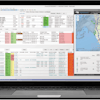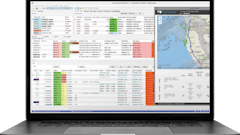
I find it inspiring when I talk with distributors that have discovered the value of meaningful data-driven decisions based on actual employee performance metrics. It reminds me of the movie Moneyball, where Brad Pitt played Oakland Athletics general manager Billy Beane. It’s a frank baseball story about a GM tasked with achieving exceptional results on a shoestring budget. The film impressed me for several reasons, but the one that really “hit home” was how the GM’s trust in sabermetrics and analytics transformed traditional scouting models and altered the game of baseball forever.
While performance metrics have been a fixture in the boardroom at many large companies for several decades now, they’re noticeably absent at far too many distribution organizations. Any modern warehouse management system (WMS) should track and display employee and warehouse productivity key performance indicators (KPIs) and offer visibility across all warehouse functions (sabermetrics for the warehouse, if you will). While most baseball teams have adopted metrics and analytics in recent years, what’s holding back so many distributors from doing the same?
Far too often, a warehouse operations manager who has implemented a WMS may postpone the use of metrics because of a belief that it’s too complicated or difficult to do so. But the real value in measuring warehouse performance is to objectively see who’s doing what and how well. But for many of the distributors that I speak with, the productivity of their warehouse is more – to borrow a line from sabermetrics skeptic and A’s scout Grady Fuson – “fortune cookie wisdom” than a science.
Visibility is key
The right WMS will help management set realistic performance standards by zone and for individuals working in those zones. The WMS should be able to identify the individuals who are performing well, and also those with room for improvement, using that data to establish benchmarks for all employees. This visibility can help expose throughput impediments, which, in turn, helps managers encourage improvements in worker performance and warehouse processes.
I’d caution that, before beginning to use metric data to report employee activities, it is important to meet with your team. Explain how the WMS will help your company serve its customers with improved shipment speed and accuracy. Also, show them how WMS reporting can expose opportunities to better train specific employees or groups. Ideally, you establish a reward program which targets results achieved with continuous improvement.
Fundamentals of WMS metrics
There are two important productivity aspects to track for each employee: 1) the transactions per hour (TPH) for each type of work in each zone, and 2) the percentage of their shift hours working WMS transactions like receiving, putaway, picking and cycle counting. A typical day is also filled with “overhead” activities such as breaks, lunch, cleanup, maintenance, sweeping or packing. Whenever your employees are not engaged in any direct work assignment, they can use their RF terminal to log into those overhead tasks. It will become second nature for the team to utilize those overhead tasks so that at the end of their shifts the system accurately portrays where and how an employee spend their time and their resulting productivity level.
Establishing fair standards
I’ve always encouraged asking warehouse workers for direction when establishing standards. You may be surprised at just how deep their interest in fairness and accountability goes. Having experience on the floor gives them invaluable first-hand knowledge of processes and problems impacting their productivity. Many companies set up a feedback loop that results in continual improvement, even if it’s just incremental.
Most importantly, these standards should be fair for the employee – and fair for the company. If your employees are held accountable to a reasonable set of performance expectations, they will be far more likely to embrace a challenge. These metrics go hand-in-hand with recognizing exceptional work when it is warranted and finding areas where more progress is needed. Once individuals are measured against standards, other aspects of metrics can be implemented – including tracking errors and on time shipments.
Metrics in action
To fully appreciate the impact of WMS metrics in action, consider the experience of Jensen Distribution Services. The idea of metrics wasn’t new to Jensen, but they had done everything manually before, with paper-based tracking. The company never had individual metrics in receiving either, so the WMS exposed both the high and low performers in this work group.
While Jensen has always encouraged performance efficiency, WMS metrics shed new light on their workforce operations. Because the company’s culture has always valued setting and meeting productivity benchmarks, getting accustomed to using the WMS to track and measure performance was a breeze. In fact, the learning curve wasn’t steep at all. Jensen’s team already had the mentality, so all they had to do was jump in and start tracking.
Jensen’s WMS allowed for quick set-up of performance standards, and instant tracking of daily warehouse tasks. The WMS has given the team much more insight into both warehouse productivity and quality operations, allowing Jensen to now track its workforce both as a force, and as individuals. It gives employees a real sense of accountability, knowing who is up to standard and who needs to work harder.
Using metrics to measure and reward
Similarly, ESP Gauges uses WMS metrics to measure individual employee performance and establish a new paradigm for rewarding top performers. The company leverages their WMS to track all activities, and then relies on the system’s metrics to establish baselines for every transaction and assigned a dollar value on productivity. For example, ESP measures how many transactions can be completed in an hour, the accuracy levels of outbound sales orders, the average number of internal errors caught through cycle counting, and more.
The company also introduced a pay-for-performance program based on the WMS’ transactions per hour metric. Upon instituting the program, employees immediately saw how the new system could affect their paychecks. ESP had some workers that achieved more than a 30% increase in pay. In a group of 20 employees, for example, the company found that it was rare to have more than three or four people who did not qualify for additional pay under the program.
The best WMS can be used to establish employee performance metrics and incentive programs that help control labor costs. With increased productivity, detailed employee performance metrics, and fair standards for measuring and rewarding your employees, your WMS gives you the ability to vastly improve operations. These changes lead to higher profitability for your business and contribute to improved customer service. That, my friends, feels as good as hitting a game-winning homerun.

![Pros To Know 2026 [color]](https://img.sdcexec.com/mindful/acbm/workspaces/default/uploads/2025/08/prostoknow-2026-color.mduFvhpgMk.png?auto=format%2Ccompress&bg=fff&fill-color=fff&fit=fill&h=100&q=70&w=100)







![Pros To Know 2026 [color]](https://img.sdcexec.com/mindful/acbm/workspaces/default/uploads/2025/08/prostoknow-2026-color.mduFvhpgMk.png?ar=16%3A9&auto=format%2Ccompress&bg=fff&fill-color=fff&fit=fill&h=135&q=70&w=240)








